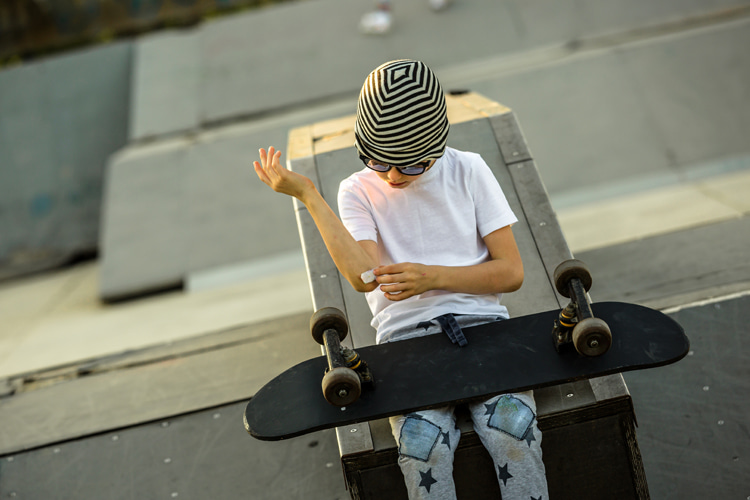
A young skateboarder takes a moment to check their arm while sitting on a ramp. The child is dressed casually with a skateboard nearby.
Breaking Barriers: The Journey of a Pro Skateboarder’s Wrist Injury
For a professional skateboarder, the body is both a tool and a canvas, etching tricks onto concrete and defying gravity with every ollie. But what happens when that tool experiences a significant setback, like a broken wrist? Let’s dive into the process of recovery and rehabilitation that follows such an injury in the world of professional skateboarding.
The Initial Impact
When a pro skateboarder breaks their wrist, the immediate aftermath is crucial. The injury typically occurs during a fall or a trick gone wrong, resulting in a fracture to one or more of the small bones in the wrist. The severity can range from hairline fractures to more complex breaks involving multiple bones or ligaments.
Diagnosis and Treatment
The first step is proper diagnosis, usually involving X-rays and potentially MRI scans to assess the full extent of the damage. Treatment options vary depending on the severity of the break but often include:
1. Immobilization: A cast or splint to keep the wrist stable and allow proper healing.
2. Surgery: In more severe cases, surgical intervention may be necessary to realign bones or repair ligaments.
3. Pain management: Medication to control pain and reduce inflammation during the initial healing phase.
The Road to Recovery
Recovery from a wrist fracture is a journey that requires patience, dedication, and a structured approach. While each case is unique, there are common elements in the rehabilitation process:
1. Physical Therapy: Once the initial healing phase is complete, physical therapy becomes crucial. Therapists work with skateboarders to restore range of motion, strength, and flexibility to the wrist. This process is similar to what other athletes undergo, as seen in the case of Olympic skier Mikaela Shiffrin, who emphasizes the importance of targeted exercises in her recovery routines. Source: Women’s Health
2. Gradual Return to Activity: Skateboarders must resist the urge to rush back onto their boards. A gradual return to skateboarding, starting with basic movements and slowly progressing to more complex tricks, is essential to prevent re-injury.
3. Strength Training: Building strength in the surrounding muscles helps support the healed wrist. This includes exercises for the forearms, hands, and even core muscles to improve overall stability.
4. Proprioception Exercises: These exercises help restore the body’s sense of position and movement, which is crucial for the precise control needed in skateboarding.
Innovative Recovery Techniques
The world of sports medicine is constantly evolving, and new techniques are being developed to aid in recovery. For instance, recent research has explored the use of bioresorbable, wireless stimulators to accelerate nerve regeneration in injuries. While this technology is not specifically designed for wrist injuries in skateboarders, it showcases the potential for advanced recovery methods in the future. Source: Nature Communications
Mental Recovery
The physical aspect of recovery is just one part of the equation. Pro skateboarders often face mental challenges during their time away from the sport. Maintaining a positive mindset, setting realistic goals, and staying connected with the skateboarding community can all contribute to a healthier recovery process.
Long-Term Considerations
Even after a successful recovery, pro skateboarders may need to make adjustments to their technique or equipment to prevent future injuries. This might include:
– Using wrist guards or other protective gear more consistently
– Modifying certain tricks or approaches to reduce stress on the healed wrist
– Incorporating regular strength and flexibility exercises into their training regimen
The Comeback
Many professional skateboarders have faced and overcome wrist injuries, returning to compete at the highest levels. The experience often leads to a greater appreciation for injury prevention and overall body maintenance.
While a broken wrist can be a significant setback for a pro skateboarder, it’s far from a career-ending injury. With proper medical care, dedicated rehabilitation, and a patient approach to recovery, skateboarders can heal and return to the sport they love. The journey may be challenging, but it often results in a stronger, more resilient athlete who has gained a deeper understanding of their body and the importance of proper care and training.
Remember, whether you’re a pro or an amateur, listening to your body and seeking professional medical advice for any injury is crucial. Stay safe, skate smart, and keep pushing the boundaries of what’s possible on four wheels and a deck.

